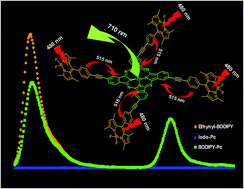A first archetype of boron dipyrromethene-phthalocyanine pentad dye: design, synthesis, and photophysical and photochemical properties
Abstract
A novel type of phthalocyanine pentad containing four boron dipyrromethene (BODIPY) units at peripheral positions of the phthalocyanine framework has been designed and synthesized for the first time. The Sonogashira coupling reaction between 4,4′-difluoro-8-(4-ethynyl)-phenyl-1,3,5,7-tetramethyl-4-bora-3a,4a-diaza-s-indacene (Ethynyl-BODIPY) and 2(3),9(10),16(17),23(24)-tetrakis(iodo) zinc(II) phthalocyanine (Iodo-Pc) has been used for the synthesis of the target compound. The BODIPY-phthalocyanine pentad dye (BODIPY-Pc) has been fully characterized by 1H NMR, MALDI-TOF mass, FT-IR and UV-Vis spectroscopic techniques and elemental analysis as well. The photoinduced energy transfer process for this dye system was explored in tetrahydrofuran solution. The singlet oxygen generation capability and photodegradation behaviours of this BODIPY-Pc pentad dye were also investigated in DMSO for the determination of the usability of this new type of dye system as a photosensitizer in PDT applications.


 Please wait while we load your content...
Please wait while we load your content...